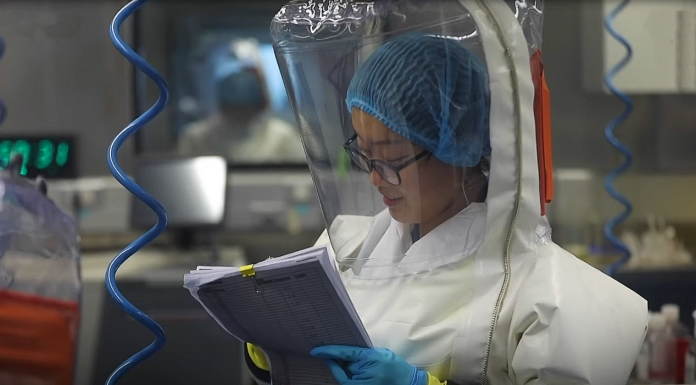The National Institute of Allergy and Infectious Disease, run for nearly 30 years by Anthony Fauci, approved nine grants that funded bat coronavirus research in China, including at the Wuhan Institute of Virology, according to documents obtained via the Freedom of Information Act.
Judicial Watch received 301 pages of emails and other documents that reveal a close relationship among federal health agencies, EcoHealth Alliance, and various Chinese institutions and researchers.
“These documents are of world-wide interest, as they suggest that the Wuhan lab had major bio-safety issues and the American government was carefully monitoring its activities from a national security perspective even while funding it,” said Judicial Watch President Tom Fitton.
“Dr. Fauci and his colleagues have some more explaining to do,” he said.
Under Fauci’s leadership, the NIAID awarded one grant each year from 2010 to 2012 to the EcoHealth Alliance—headed by Peter Daszak—for collaborative research with Jinping Chen of Guangdong Entomological Institute in China.
The grants funded research into the “Risk of Viral Emergence from Bats.”
NIAID awarded another grant to EcoHealth Alliance in 2012 for research called, “Comparative Spillover Dynamics of Avian Influenza in Endemic Countries.”
EcoHealth Alliance partnered with Xiangming Xiao of the East China Normal University for the research.
NIAID gave EcoHealth Alliance one grant each year from 2014 to 2018 for a study titled, “Understanding the Risk of Bat Coronavirus Emergence.”
EcoHealth Alliance partnered with Changwen Ke of the Centers for Disease Control and Prevention of Guangdong in China during those years.
Judicial Watch identified 2,221 NIH grants that funded a “Chinese Collaborator.”
Fauci’s agency, the NIAID, awarded 490 grants, while the other 19 NIH agencies combined awarded 1,731 grants.
NIH grants funded research at 261 universities, laboratories, and private companies in Australia, Canada, China, the UK, the US, and Thailand.
Although US taxpayers funded this research, the Chinese and American governments have hidden the findings from their people.
Neither American nor Chinese sources, for example, will reveal where the SARS-like coronavirus that most closely resembles SARS-CoV-2—the virus that causes COVID-19—came from.
Beyond confirming Fauci’s grants to Chinese researchers, the records show that American organizations and Chinese partners openly discussed research on coronaviruses, that the Wuhan lab did not initially have the disinfectants needed to safely research them, and that Chinese researches hid key discoveries from the United States.
Wuhan Institute of Virology Vice Director Yuan Zhiming revealed the lab’s inexperience with handling highly infectious diseases in an email titled, “Asking for help.” Zhiming sent the email to National Institutes of Health virologist Jens Kuhn.
Zhiming requests help finding “disinfectants for decontamination of airtight suits and surface decontamination” because the lab has tried “several” but has not “found a good candidate.” He did, however, confirm that the lab was operating “without pathogens.”
“I hope you can give us some help, to give us some suggestion for the choice of disinfectants used in P4 laboratory,” he said, with a reference to the highest bio-security level.
The email shows that the Wuhan Institute’s director—tasked with running China’s first P4 laboratory—did not know what disinfectants to use.
After the coronavirus outbreak, Kuhn told two NIH colleagues that he has known “Zhiming for quite some time and also met him personally in Wuhan twice.”
The emails further establish the working relationship between America’s public health bureaucrats and Chinese virus researchers.
Dr. James Leduc, who leads the NIH-funded biosecurity lab at the University of Texas in Galveston, initiated contact between Dr. Ping Chen, the NIAID Representative in China, and Zhiming.
Leduc himself said that he had met Zhiming “repeatedly.”
Leduc sought to “form long-term scientific and technical collaborations with the new BSL4 laboratory” in Wuhan that will fit with the vision of the Global Health Security Agenda.
Chen also visited the Wuhan Institute of Virology and emailed a “trip report” on Oct. 26, 2017. The email included a photo of the building’s exterior, though Chen noted that “we are not allowed to take photos” inside the laboratory.
Although the NIH funded Chinese researchers, they were not forthcoming with their findings.
Chen informed officials within the federal government that he learned about a “type of new flu vaccine using nano-technology from China’s Wuhan Institute of Virology” but that the Chinese government had blocked websites with information about the tecnhology.
In the email to American officials, Chen wrote that, “The intranasal nano-vaccine can target broad-spectrum flu viruses and induces robust immune responses.”
Other documents reveal frank and oftentimes celebratory discussions about coronavirus research.
A World Health Day bulletin includes among the “successful activities” from the US-China partnership the “detailed surveillance throughout China and in other countries on the emergence of coronaviruses” and the China sending the NIH influenza samples to “assess risks associated with emerging variants for pandemic and zoonotic threat.”
Judicial Watch’s FOIA request is ongoing. NIH has agreed to release 300 pages of documents each month through November until the request is fulfilled.

